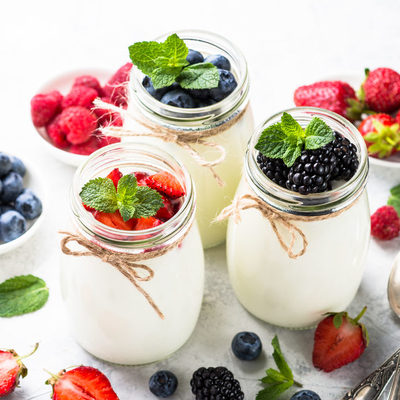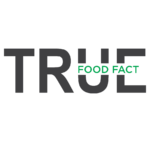
Yogurt
Also known as Yoghurt, Kefir
What is yogurt?
Found in the refrigerated case, yogurt is a food product made from fermenting milk with live bacteria. The bacteria used for the fermentation process are known as cultures. While this is commonly made with cow’s milk, there are styles made from goat, camel, yak, and other animals’ milk.
- At the supermarket, you can find this food in varieties such as traditional, Greek, low-fat, fruit-flavored, kefir, and non-dairy.
- Each year, Americans consume more than 300,000 tons of yogurt.
The top 8 best supermarket yogurts, according to Good Housekeeping are:
- Oikos Triple Zero Vanilla Greek
- Dannon Light & Fit Vanilla Greek
- Chobani Plain Nonfat Greek
- Fage Fat-Free Greek
- Wallaby Organic Greek Plain Nonfat
- Siggi’s Strained
- Fage Total 2%
- Stonyfield Organic Greek Plain 0% Fat
Origin
Ancient texts have led historians to believe that yogurt was already being consumed sometime between 10,000 – 5,000 BC. During a time when the people had already domesticated animals, the development of this food product likely happened by accident. In 6,000 BC, there is proof of this food being used in Indian Ayurvedic rituals for its healing properties. Yogurt quickly spread to other regions and by 2,000 BC, much of the population was used to consuming it. However, the first written record of this food did not occur until 100 BC in the Greek Empire.
Since the 1st century, yogurt has been an indispensable part of Turkish cuisine (this word even stems from the Turkish language.) Legend has it that yogurt also cured a French King’s digestive issues in the 16th century and became popular throughout the country. Immigration, travel, and trade brought this food product to the Americas in the 17th century where it flourished. By the early 20th century, this food was viewed as promoting health and longer lives, leading to its mass production in Europe. In 1981, the FDA regulated what could and could not be considered yogurt, thereby standardizing this food’s commercial production.
Function
Although this is a popular breakfast or snack food, it can also be added a lot to sweet and savory dishes in the kitchen. This food helps cool down spicy dishes like curry, dress salads, and craft luscious desserts. You can even use it as a marinade as the enzymes in yogurt help break down meat and fish to achieve the perfect tenderness. Add a creamy, tangy flavor to roasted vegetables, dips, fluffy cakes, or crispy toast. This tasty dairy product brings endless possibilities to transform your next meal.
Nutrition
Yogurt is a nutritious food that contains plenty of vitamins and minerals such as:
- Vitamin B6
- Vitamin B12
- Calcium
- Selenium
- Magnesium
- Zinc
This dairy product also contains protein, riboflavin, pantothenic acid, and thiamin. It is probiotic which means that it promotes a healthy gut and good digestion. Studies suggest that the bacteria in this food can help maintain a healthy weight, as well as protect against heart disease and diabetes.
Commercial production
Commercially produced yogurt is commonly made using a combination of powdered milk products and cream. These ingredients are then blended and heated to 176°F to pasteurize the mixture. To keep the milk and cream from separating, the yogurt is then homogenized in a machine that crushes fat globules. After that, the mixture is sent to metal tanks to be fermented at 113°F and live bacteria are added. Once completed, this food is packaged into plastic containers, placed in boxes, refrigerated and ready for distribution.
Uses
As a dairy product, it’s crucial to store yogurt correctly and follow the best-by date in order to prevent foodborne illnesses. This creamy food product should always be kept in an airtight container away from strong odors. It’s also best to keep it consistently cool, so avoid storing it in the refrigerator door where temperatures will fluctuate. To prevent cross-contamination, don’t eat directly from the container and instead serve yourself in a separate bowl.
Recipes
You can enjoy yogurt on its own or in a dish with its milky flavor and creamy texture. Here are some popular recipes.
FDA Regulation
The Food & Drug Administration has strict regulations concerning the standards of milk and cream to be used in yogurt. Before adding any flavors, the FDA requires that this dairy product contain at least 3.25% milkfat and 8.25% percent milk solids not fat. This regulation also indicates the labeling protocol that commercial producers of this food should follow. The FDA also only considers foods fermented with two types of bacteria, Lactobacillus bulgaricus and Streptococcus thermophilus, to be yogurt.
References
Fisberg, Mauro, and Rachel Machado. “History of Yogurt and Current Patterns of Consumption.” Nutrition Reviews, Oxford University Press, 11 July 2015, academic.oup.com/nutritionreviews/article/73/suppl_1/4/1819293.
Danone. “The Great History of Yogurt.” Medium.com, Medium, 27 July 2016, medium.com/@Danone/the-great-history-of-yogurt-2f3065eca4eb.
“Yogurt.” The Nutrition Source, Harvard T.H. Chan School of Public Health, 4 June 2019, www.hsph.harvard.edu/nutritionsource/food-features/yogurt/.
“CFR – Code of Federal Regulations Title 21.” Accessdata.fda.gov, U.S. Food & Drug Administration, 1 Apr. 2019, www.accessdata.fda.gov/scripts/cdrh/cfdocs/cfcfr/CFRSearch.cfm?fr=131.200.
